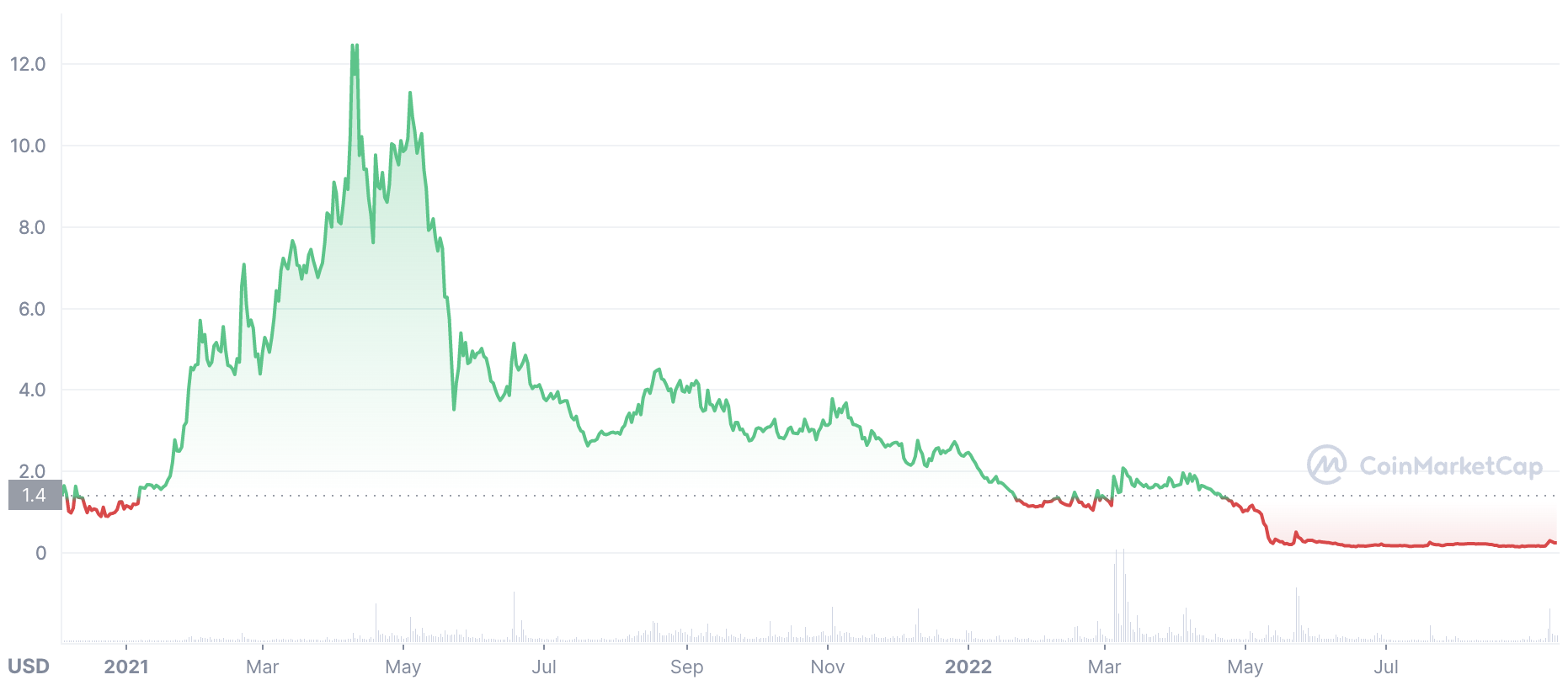Mirror Protocol price prediction: Will MIR bounce back?
MIR has struggled with the crash of LUNA. What is next for the DeFi token?
Decentralised finance (DeFi) is one of the most popular trends in the cryptocurrency space. It offers the major functions of the traditional financial system in an open, decentralised, permissionless and autonomous approach.
Mirror protocol is a DeFi platform that is improving the accessibility and cost of investing in assets, including stocks and cryptocurrencies. But as a Terra-based protocol, the price of its native MIR cryptocurrency suffered greatly from the crash of LUNA.
However, MIR was showing signs of recovery as of 12 September 2022, with it up 46% over the past week.
Can the MIR token price bounce back in the coming days and outshine its competition?
This article covers fundamental analysis, along with Mirror Protocol cryptocurrency price analysis and recent news and developments to help you form a plausible MIR price prediction.

What is Mirror Protocol and how does it work?
Mirror is a DeFi protocol fuelled by Terra’s smart contracts. It permits the development of synthetic assets called Mirror Assets (mAssets).
mAssets replicate the price behaviour of real-world assets and provide traders anywhere in the world with full access to price exposure without the associated costs of owning or trading real assets.
The minting of mAssets is decentralised and is carried out by users across the network via the establishment of positions and the deposit of collateral. Mirror guarantees that the protocol always has enough collateral to support mAssets, and also administers markets for mAssets by listing them on Terraswap against TerraUSD (UST).
Mirror Token (MIR) is the governance token for the Mirror Protocol. It is essential for staking and voting on ongoing polls, and as a deposit for creating new governance polls. In future versions of Mirror, it will fulfil additional functions that expand the protocol’s usability and value.
Additionally, users that stake MIR tokens gain MIR payouts on collateral withdrawals from collateralised debt positions (CDP) inside the network.
What makes Mirror Protocol unique?
Mirror Protocol is an interchain DeFi protocol, which means that it can be accessed and interacted with across various blockchains.
The Terra blockchain, upon which Mirror Protocol is constructed, makes interchain transactions possible between Terra (LUNA), Ethereum (ETH), and the Binance Smart Chain through the Shuttle bridge.
Terra Bridge is a web application that offers a web interface for transferring tokens across multiple blockchains.
Mirror Protocol news and price drivers
The Mirror Protocol cryptocurrency has undergone a number of important milestones and developments lately, which may drive the MIR coin value:
Partnership with UniLend
Mirror Protocol announced a critical partnership with UniLend, a decentralised money market protocol, in January 2021.
Mirror Protocol connected its key mAssets to UniLend’s lending protocol. As a result, the mAssets will act as collateral for borrowing. To generate profit, they can be placed on UniLend’s platform by liquidity providers (LPs).
According to the announcement, this will be the first time synthetic stocks are utilised as collateral in a DeFi money market protocol.
Launch of Mirror Protocol v2
In June 2021, Mirror Protocol announced version 2 of its network. This new version includes additional features that enhance the current processes in v1 and ensure that all classes of users are suitably rewarded for their protocol-related contributions.
Active voters are eligible for enhanced voting awards in addition to the current governance staking rewards in Mirror Protocol v2. Additionally, an ‘abstain’ vote option is added for users who want to engage actively in governance but believe they do not understand the proposal adequately.
One of the most significant difficulties with Mirror Protocol v1 was the persistent pricing disparity between Terraswap and Oracle prices. As a result, a user would have to mint an asset and then sell it against Terraswap pools to mitigate price premiums.
Mirror v2 introduces a new non-tradable currency called short LP (sLP) tokens, which are generated when a short position is created. sLP tokens are also stakeable, and they create a reward that changes dynamically depending on the current price premium between Terraswap and Oracle.
MIR/USD price analysis
According to ICO Marks, MIR token’s ICO concluded in December 2020 at a token price of $0.106.
Based on the earliest available data from 2020, the MIR token price declined from $1.41 on 4 December to $0.90 on 21 December 2020. It closed the year at $1.08.
At the beginning of 2021, the broader crypto market was bullish and several altcoins, including MIR, added exponential gains. For example, MIR reached $7.07 on 21 February 2021 and then spiked to an all-time high price of $12.46 on 11 April 2021.
After that rally, a retracement brought the price to $3.52 on 23 May 2021, a decline of nearly 72% from the all-time high price. It was in line with the bearish crypto market sentiment during that period. Bitcoin (BTC) declined from a high of $63,503 on 13 April to a low of $34,770 on 23 May 2021.
The general crypto market turned bearish in May 2021 when Elon Musk tweeted about discontinuing Bitcoin payments for Tesla cars. Moreover, around the same time, the Chinese government strengthened its cryptocurrency crackdown.
The bearish market continued, and the MIR token further declined to $2.63 on 20 July 2021. It continued trading in a sideways market afterwards and reached $3.78 on 3 November 2021 before collapsing again to $2.13 on 14 December 2021. It closed the year at $2.44.
MIR token continued its bearish momentum in 2022 and declined to a 52-week low of $0.99 on 24 February 2022. During this period, the overall market sentiment became fearful amid the outbreak of the Russia-Ukraine military conflict.
The collapse of the Terra ecosystem, the network that the protocol is built on, was especially damaging to MIR. It crashed from $1.06 on 7 May 2022 to a low of $0.20 on 13 May 2022.
It has struggled to recover from this and, as of 12 September 2022, MIR was trading at $0.25. However, it has started to make progress recently, with it up 46% over the past seven days.
This price rise follows a surge in Terra’s LUNA2 cryptocurrency and its original Terra Classic coin. LUNA2 was up 170% over the past seven days and LUNC saw a rise of 41% during the same peroid, as of 12 September 2022.
While the reason behind LUNA’s rally is unclear, Terra Classic had started to implement new features, including a transaction tax and staking options.
MIR/USD price chart, all-time performance
 Source: CoinMarketCap
Source: CoinMarketCap
But what could these breakouts mean for Mirror Protocol’s native cryptocurrency?
Mirror Protocol price prediction: Targets for 2022-2031
The short-term MIR prediction from CoinCodex, based on technical analysis, remained bearish as of 12 September 2022, with 13 indicators giving bullish signals and 15 bearish.
Its Mirror Protocol price prediction for 2022 anticipated it to have dropped by 14% in a month’s time, to $0.215 on 12 October 2022.
Meanwhile, several algorithm-based forecasting services gave contrasting long-term MIR crypto price predictions as of 12 September 2022.
WalletInvestor’s MIR crypto price prediction was also bearish and considered MIR to be a “bad” long-term investment. The average price of MIR could be $0.0453 in a year, the site said. Its five-year MIR coin price prediction suggested the token could have dropped to $0.0139.
Meanwhile, DigitalCoinPrice’s MIR crypto price prediction was moderately bullish. It estimated that the Mirror Protocol cryptocurrency could hit $0.33 in 2022. Its Mirror Protocol price prediction for 2025 averaged out at $1.04 and anticipated it to have climbed to $3.56 by 2030.
In contrast, PricePrediction shared extremely bullish long-term Mirror Protocol coin price predictions. It estimated that the average price of MIR could reach $0.18 in 2022 and $0.90 in 2025. Its Mirror Protocol price prediction for 2030 suggested a maximum price of $7.17.
When looking for MIR forecasts, bear in mind that analysts and algorithm-based projections can be wrong. Their Mirror Protocol crypto price predictions are based on fundamental and technical studies of a cryptocurrency’s past performance. Past performance is no guarantee of future results.
Note that it is important to do your own research and always remember your decision to invest in MIR or any other coin depends on your attitude to risk, your expertise in the market, the spread of your investment portfolio and how comfortable you feel about losing money. You should never invest money that you cannot afford to lose
FAQs
Is Mirror Protocol a good investment?
Mirror Protocol is a DeFi protocol that was introduced in December 2020. It allows for the creation of synthetic assets that replicate the price of real-world assets. Since achieving an all-time-high in April 2021, its price movement has been bearish.
Whether the Mirror Protocol cryptocurrency is a good fit for your investment portfolio depends on your circumstances and risk tolerance. You should consider the level of risk you are ready to take before investing, and never invest any money you can not afford to lose.
Will Mirror Protocol go up or down?
At the time of writing, forecasters were divided over the MIR price prediction. Wallet Investor and CoinCodex anticipated a decline for the cryptocurrency, whereas DigitalCoinPrice was bullish.
In volatile cryptocurrency markets, it is important to do your own research on a coin or token to determine if it is a good fit for your investment portfolio. Whether MIR is a suitable investment for you depends on your risk tolerance and how much you intend to invest, among other factors.
Keep in mind that past performance is no guarantee of future returns, and never invest money that you cannot afford to lose.
Should I invest in Mirror Protocol?
Mirror Protocol has been on a downward trajectory, which was fuelled by the collapse of the Terra ecosystem. However, it was showing signs of recovery as of 12 September 2022, being up 46% over the past week.
Whether you should invest in MIR is a question that you will have to answer for yourself. Before you do so, you will need to conduct your own research. Never invest more money than you can afford to lose, because prices can go down as well as up